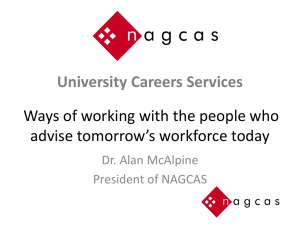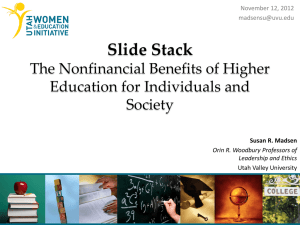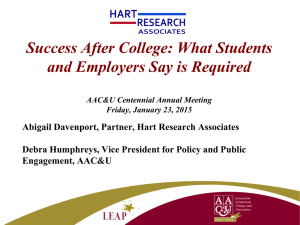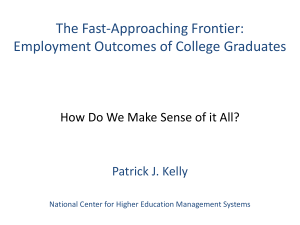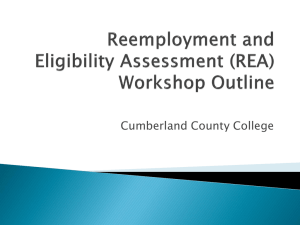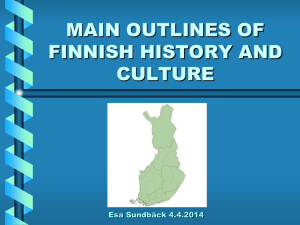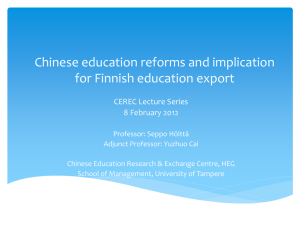Dia 1
advertisement
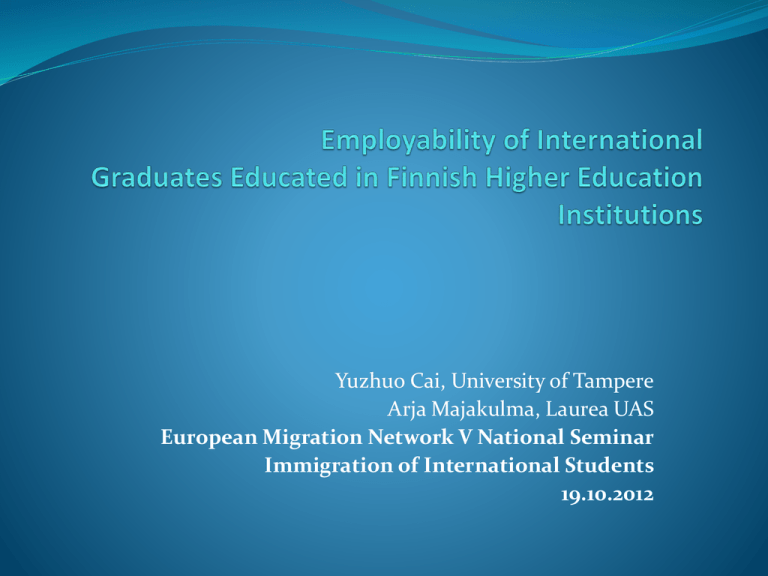
Yuzhuo Cai, University of Tampere Arja Majakulma, Laurea UAS European Migration Network V National Seminar Immigration of International Students 19.10.2012 Description of the studies VALOA study: international graduates (2009-10) from Finnish 15 HEIs (survey with 363 respondents 10 interviews with graduates and 10 with employers) Majakulma’s study: Statistics from Statistics Finland in 2008: graduates from all programmes (N=103 313) and graduates from English programmes (N=4673) at UASs in 2002-2006 according to country of birth and main activity. 21 interviews of graduates from different fields of study and national backgrounds. Aim of the studies How is the employment of international graduates in Finland? Which factors affect the graduates’ employability in the Finnish labour market? How should higher education develop the graduates' emplyoability? Location after graduation (VALOA) 90.0 % 80.0 % 77.9 % 70.0 % 60.0 % 50.0 % 40.0 % 30.0 % 20.0 % 12.6 % 9.5 % Returned to home country Moved elsewhere 10.0 % 0.0 % Settled in Finland 4 Employment rate (VALOA) 70% of all respondents are currently employed (N=253) Among those who are not employed (N=110), 61% are undertaking further studies, 11% are doing internship, 29% are taking care of family, 12% are in other situation. 5 Employment of UAS graduates from English programmes– (Majakulma) 13% of all graduates from English programmes had left Finland The employment rate of Finnish graduates was much higher (82%) than the employment rate of international graduates (59%). International graduates were more (8%) unemployed than Finnish graduates (4%). There were also more (12%) fulltime students among the international graduates, 6% of Finnish graduates were fulltime students. The proportion of others was clearly higher among international graduates. According to a recent analysis of statistics by CIMO http://www.cimo.fi/instancedata/prime_product_julkaisu/cimo/embeds/cimowwwstruc ture/25784_tilanne2010.pdf The status of 2009 graduates from all HEIs with foreign nationality in 2010 51% were employed in Finland 25% had left Finland 7% were studying in Finland 17% were otherwise in Finland differences according to the fields of study Employment by regions (VALOA) 8 Status according to regions – English programmes – (Majakulma) Figure 2. Status according to the continents of birth 100 % 90 % 80 % 70 % 60 % Status Other % Fulltime students % Unemployed % Employed % 50 % 40 % 30 % 20 % 10 % 0% Finland Europe North America South America Continent of birth Africa Asia The relevance of current job to the level of education attained in Finland (VALOA) 10 Job satisfaction (VALOA) 11 Skills / competences affecting employability • Proficiency in Finnish, understanding and • • • • • knowledge of the Finnish society Personality – also employers highlight generic skills Professional / subject-specific competence, working experience Cultural competence Job seeking skills Social networks Obstacles to finding a job in Finland (VALOA) 13 How could education be developed? Recommendations for HEIs 1 Strategic marketing activities - recruiting most gifted or relevant students Integration to Finland: Finnish and Swedish language studies especially advanced studies teaching methods are criticised being too grammar oriented cultural knowledge but also international and intercultural competence Recommendations for HEIs 2 Connections to the labour market Enhancing the labour market relevance of university studies paying more attention to the needs in the labour market, more cooperation with potential employers in curriculum design and teaching Trying to project the prospective labour markets for the students Helping students identify possible internships, employers and target labour markets (in different contexts) 15 Recommendations for HEIs 3 Reflection of self-development / professional development relevant soft/generic skills are expected to be developed during studies pay attention to context-specific knowledge and skills Job-seeking skills Learning methods, mix of international and local students Universities should strive to make the curriculum offered in English equal (but not similar) to that offered in Finnish Many important courses are available only in Finnish or Swedish 16 Recommendations for HEIs 4 Promoting graduates to employers most employers’ perception of the skills of international graduates are intuitive more information and channels to be developed for the employers to have a true picture of the graduates Developing alumni activities keeping a e-mail database of your graduates and collecting feedback from them on the relevance of HE to the world of work tracking their employment situation for self-evaluation and marketing purposes 17 Employers needs vs. Universities’ missions Universities are developing students employability for employers’ needs, but how about if employers’ perceptions are wrong? Employers may be wrong in identifying perspective employees, understanding competences and potentials of graduates, predicting possible added values brought by the graduates Universities are not just about preparing students for the future needs in the labour market, but also transforming the future of labour market and bring in new values to the society. Recommendations for HEIs 5 Instead of imposing certain ideas on employers, universities should join together with employers in developing common belief systems based on mutual understandings. Universities need to engage with employers in order to gain a grounded understanding of how their perceptions about graduates capabilities are developed. Yuzhuo Cai’s new book, Understanding Employers’ Perceptions of International Graduates, provides a conceptual framework for understanding the processes in which employers develop their beliefs on the value of graduates with similar educational credentials. More information: Cai, Yuzhuo 2012: Understanding employers’ perceptions of international graduates: An investigation of the employment prospects of Finnish-educated Chinese graduates in Finnish companies operating in China. Tampere: Tampere University Press. Shumilova Yulia, Cai Yuzhuo, Pekkola Elias 2012. Employability of International Graduates Educated in Finnish Higher Education Institutions. Valoa project, Univeristy of Helsinki. Majakulma Arja 2011: The Employment of International Graduates - A case study: Finnish Universities of Applied Sciences. In Internationalisation of European Higher Education. An EUA/ACA Handbook, European University Association, Academic Cooperation Association. Raabe. Majakulma Arja 2011: Enhancing the Employability of International Graduates during Education – A Case Study based on Finnish Universities of Applied Sciences. In Ammattikasvatuksen aikakauskirja 2.2011. Majakulma Arja 2011: Ammattikorkeakouluista valmistuneiden ulkomaalaisten työllistyminen. In Rinne R, Tähtinen J, Jauhiainen A, Broberg M. (eds.) Koulutuspolitiikan käytännöt kansallisessa ja ylikansallisessa kehyksessä. FERA, Suomen kasvatustieteellinen seura ry.

